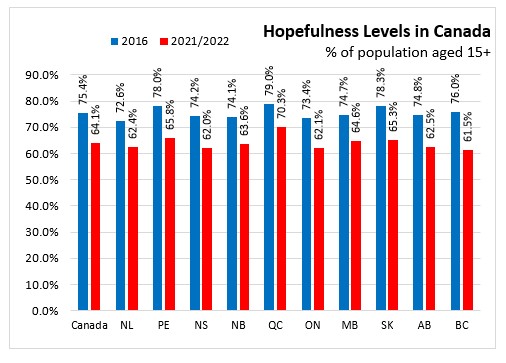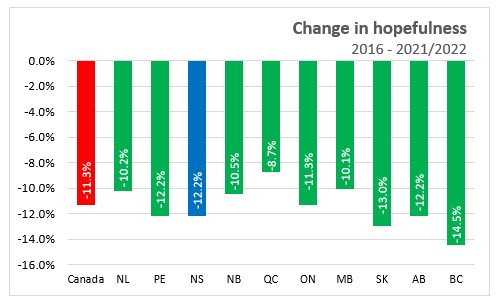The Economics and Statistics Division maintains archives of previous publications for accountability purposes, but makes no updates to keep these documents current with the latest data revisions from Statistics Canada. As a result, information in older documents may not be accurate. Please exercise caution when referring to older documents. For the latest information and historical data, please contact the individual listed to the right.
<--- Return to Archive
For additional information relating to this article, please contact:
May 17, 2022HOPEFULNESS IN CANADA, 2016 and 2021/2022 Statistics Canada released a new article today that examines the future outlook of the Canadian population using new data from the Canadian Social Survey (CSS).
Future outlook, an indicator in the Quality of Life Framework, is measured with the following question in the Canadian Social Survey: "Thinking about your life in general, how often would you say you have a hopeful view of the future?" Responses of always or often are used in this release to indicate having "a hopeful outlook on the future."
This article provides an overview of how hopeful different segments of the Canadian population (those aged 15 and older living in 10 provinces) generally felt about their future between August 6, 2021 and March 13, 2022.
At the national level, Canadian are feeling less hopeful about the future compared with how they felt in 2016.
In Nova Scotia, the proportion of people reporting a hopeful outlook on the future declined from 74.2% in 2016 to 62.0% in 2021/2022.
Quebec's population was the most hopeful about the future in 2021/2022 (70.3%), followed by Prince Edward Island (65.8%) and Saskatchewan (65.3%).

British Columbia experienced the largest decline in the proportion of people reporting a hopeful outlook on the future between 2016 and 2021/2022 (from 76.0% to 61.5%). Quebec reported the smallest decline in the proportion of people reporting a hopeful outlook over the same period.

Between 2016 and 2021/2022, younger Canadians reported a larger decline in hopefulness compared with older population.
In 2016, nearly 8 in 10 Canadian aged 15 to 34 were always or often hopeful about the future compared with 7 in 10 persons aged 65 and older. In 2021/2022, 63% of those aged 15 to 34 had a positive outlook. This was close to the proportion of older Canadians reporting a hopeful outlook in 2021/2022.
Women (65%) held a slightly more hopeful view of the future than men (63%) in 2021/2022. However, transgender and non-binary individuals were considerably less hopeful about their futures (38%) compared with cisgender people.
Nearly one-half of LGBTQ2+ individuals had a positive outlook on the future (49%). This was lower compared to the 65% non-LGBTQ2+ individuals. Within the LGBTQ2+ population, about 52% of those who were lesbian or gay, 49% of those who were bisexual, and 44% of those with another sexual orientation had a positive outlook on the future.
53% of persons with a disability, difficulty or long-term condition reported a hopeful outlook in 2021/2022 compared with 72% of the rest of the population. Among persons with a disability, difficulty or long-term condition, women (55%) had a slightly more positive view of the future than men (51%).
Households that experienced financial difficulty meeting basic household needs during the pandemic, such as transportation, housing, food and clothing, had a less hopeful view of the future than those who did not experience financial hardship (47% versus 69%) in 2021/2022.
66% of those who were employed were more hopeful about future when compared to 51% of those who were looking for paid work in the week prior to completing the survey.
55% of individuals who experienced discrimination or unfair treatment in the past five years were hopeful about the future, while 68% of those who did not have those experiences held a hopeful outlook.
Some population groups reported above-average hopefulness about their futures, including the Black Canadian population (73%), recent immigrants (74%) and non-permanent residents (72%).
70% of Canadians who lived in multiple-person households with children were hopeful about the future compared to 64% of those living in multiple-person households without children and 56% of those living alone. Canadians on maternity, paternity or parental leave reported some of the highest levels of hopefulness (83%).
78% of Canadians who had a strong sense of belonging to their local community always or often had a hopeful view of the future compared to 35% of people who always or often felt lonely.
Source: Statistics Canada. Hopefulness is declining across Canada: having children or strong ties to a local community associated with a more hopeful outlook
<--- Return to Archive